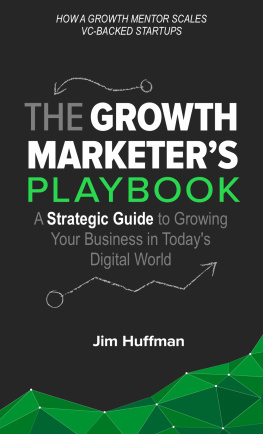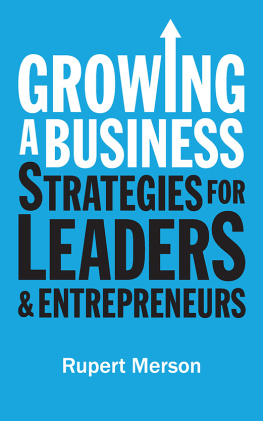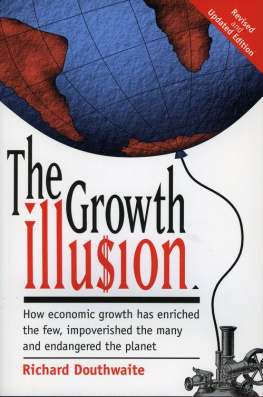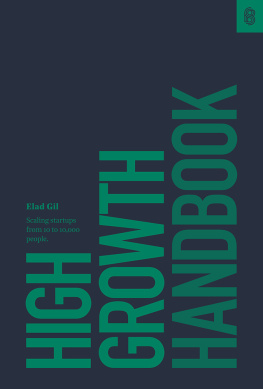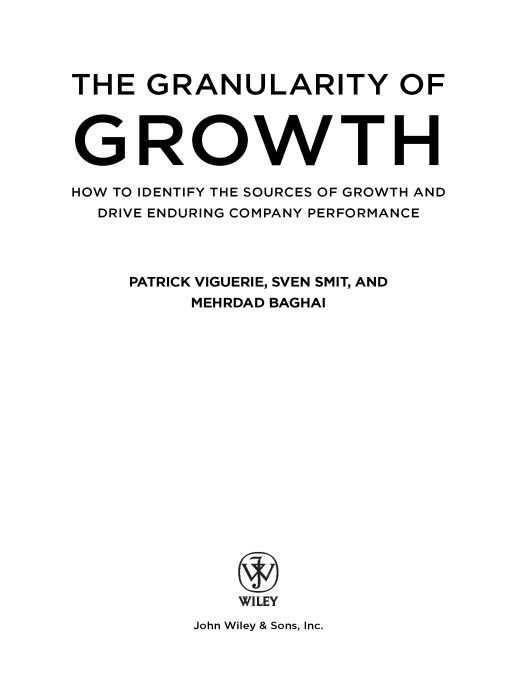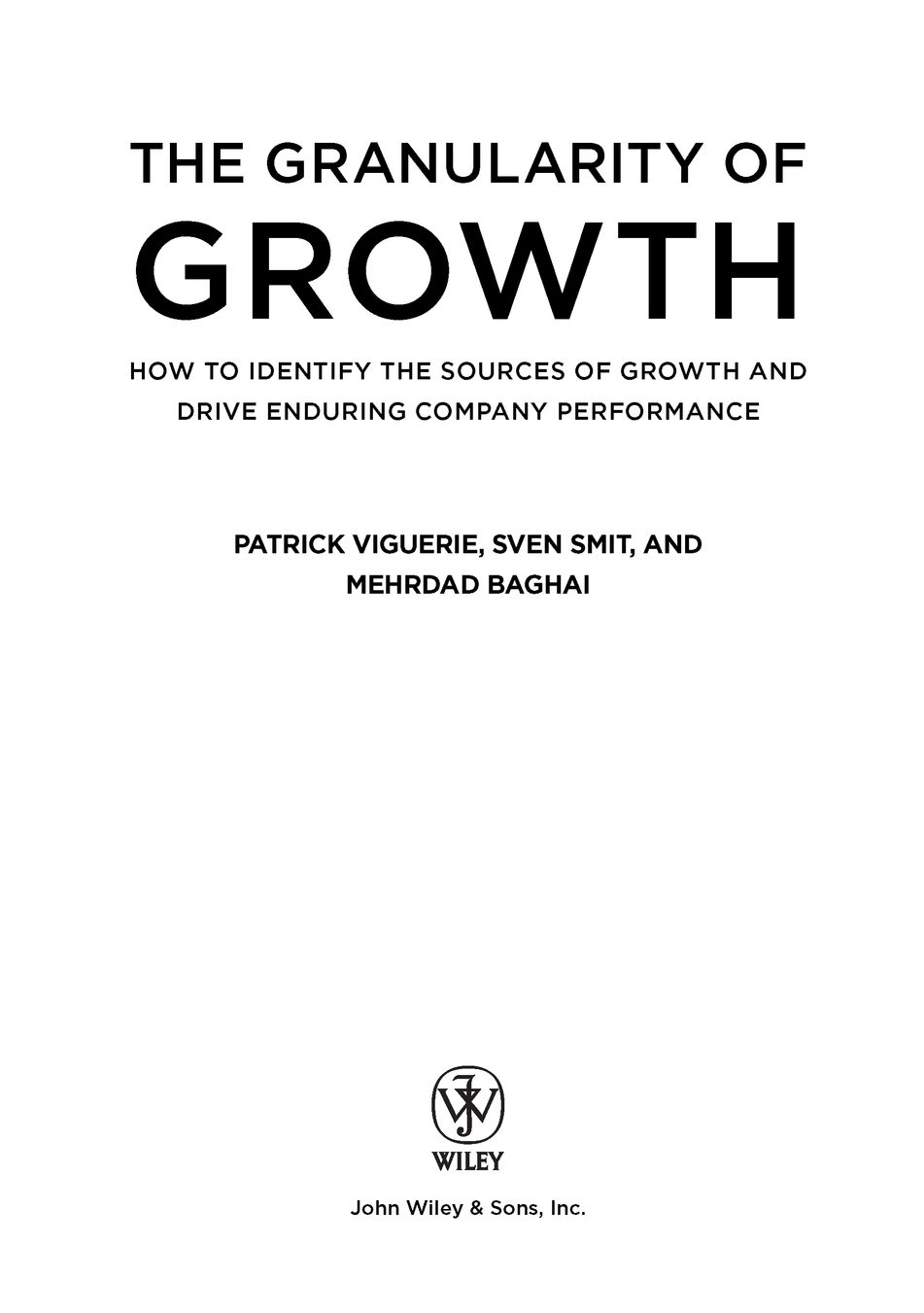Table of Contents
To
Susie, Shaun, Alex, and Sam Viguerie
Bibi and Veerle Smit and Jan Ferdel Smit, an ideas man
Roya and Naysan Baghai
Special thanks
We owe a great deal of gratitude to our partner Angus Dawson, who for all intents and purposes has been the fourth author of this book. He has been instrumental in the development and refinement of our thinking, especially on the architecture for growth. As McKinseys growth service line leader in Asia, he has also ensured a more global orientation to our work. In addition, he has led the writing of The Granularity of Growth: Asia, a companion volume that explores the particular opportunities and challenges of growth in this most dynamic and fast-changing region.
We have also been lucky to have truly gifted team leaders who have superbly managed our many working teams. Carrie Thompson and Martijn Allessie were our first thought partners and the leaders who led our teams through the murkiest days of the research. Ralph Wiechers subsequently picked up the team leadership role and drove the advancement and refinement of our thinking brilliantly.
Quite simply, there would be no book without the four of them.
Acknowledgements
This book is the product of a collaboration among many people. Our clients, colleagues, friends, and families have all made major contributions to our thinking and we would like to recognize and thank them for their support.
First, and most important, we want to thank our clients who have encouraged us to develop our ideas. Achieving and sustaining growth in multi-billiondollar corporations is a serious leadership and management challenge. Our ideas have benefited enormously from our work with clients who have taken on this challenge.
We thank those who, as reviewers, braved early drafts of this book to give us feedback and encouragement. In particular, we appreciate the frank and constructive voices of Charles Conn, Costas Markides, Anita McGahan, David Redhill, and Phil Rosenzweig in helping us to reshape our thinking.
We acknowledge the support of our partners who have supported our multiyear research effort. Beyond funding, our colleagues have contributed enormously to the ideas we put forward on their behalf and to their application in real corporate environments. Without their intellectual challenges and the ability to test our ideas, no book would have been possible. We would also like to note the leadership of Ian Davis, Lenny Mendonca, Scott Beardsley, Gordon Orr, and Peter Bisson, who have been advocates and sponsors of our work inside and outside McKinsey.
While scores of other partners have contributed to McKinseys work on growth, we would like to mention specifically Claudio Feser, Will Garrett, Carlo Germano, Asmuss Komm, Robert Palter, Stefano Proverbio, Occo Roelofsen, and Stefano Visalli. We also acknowledge the original contributions made by our former partners Steve Coley and David White to our early thinking on growth.
Our teams conducted painstaking, detailed analysis and case research that not only formed the analytical basis for our idea development but also provided extraordinarily valuable documentation of case studies. At one time or another, all of the following made significant contributions to our work: Kevin Cheng, Abhijeet Dwivedi, Olga Hallax, Giovanni Iachello, Robert Mulcare, Carlos Ocampo, Amee Patel, Sejal Patel, Mary Rachide, Gajan Retnasaba, Namit Sharma, Christian Snderstrup, Teun van der Kamp, and Robert Weston. We are also indebted to the hard work of the entire team at McKinsey Knowledge Center in India: Megha Agarwal, Ankit Ahuja, Ripsy Bakshi, Vineeta Chopra, Chintan Dhebar, Sumit Dora, Himanshu Jain, Amit Jeffrey, Dipty Joshi, Vipin Karnani, Rohit Malhotra, Amit Marwah, Devesh Mittal, Bhawna Prakash, Mudit Sahai, Abhishek Sharma, Amit H. Sharma, Ashish Sharma, Sidhartha Sharma, Richa Suri, and Sakshi Trikha.
We also want to make a special acknowledgement to Ivan Hutnik and Jill Willder who, through many tireless hours, helped us to synthesize our thinking and express our thoughts more clearly and succinctly. They have been an invaluable source of intellectual challenge, and, indeed, have played a real role in the refinement and articulation of our ideas.
Pom Somkabcharti and Martin Liu of Cyan Books have worked with us during this entire research and writing effort. Pom in particular has been an enduring source of encouragement, emotional support, creative magic, and hands-on work to drive our publishing effort. Both have believed in our project from the outset and been tireless advocates for its success. We are truly indebted to them. We would also like to thank Pamela van Giessen and her team at Wiley for all their hard work to make our North American edition a success.
And, of course, none of this would have been possible without the professional assistance of Nichole Brien, Marije Kamerling, Vicki Lunceford, and Emma Peachey who helped us through the many iterations of the manuscript. We are thankful for their professionalism and constant support.
Finally, we note the influence that McKinsey legend Marvin Bower has had on our thinking. We remember him best by a remark he made at a partners conference:
For the future, my great ambitionand Im assured its being carried outis that we produce a firm that is going to continue indefinitely into the future. There arent many organizations of that sort.
Preface
After a brief spell out of the management limelight, growth has once again taken center stage. Following the collapse of the internet bubble, it disappeared from view for a while as companies scrambled to rebalance their businesses by focusing on execution. But now its back, and with a vengeance.
Of course, growth never really went away as a management concern. Without growth, companies cant hope to deliver the continuous increase in revenues and returns that shareholders are looking for. As CEOs are only too aware, such expectations arent easy to meet and involve much more than simply steering the performance of the business. The markets take competence and effective delivery for granted, and discount them; what they want to see is performance beyond the current trajectory. But where will this growth come from?
The nature of the challenge
The purpose of this book is to answer that question by exploring the particular challenges faced by large corporations in driving and sustaining growth.
The first of these is a basic numbers problem: the bigger you are, the harder it is to drive the next quantum of growth. Take the median Fortune Global 500 company with roughly US$25 billion in revenue. To sustain growth at just the rate of global GDP growth (say, roughly 6.2 percent), it needs to find about US$1.6 billion in incremental revenue every year. As Procter & Gambles CEO said recently, his companys growth challenge is to add a business the size of its entire UK operation or a brand the size of Tide every single year!
The second challenge facing large companies has to do with longevity: the longer youve been in business and the larger you are, the more likely it is that your business is maturing. As it does so, it will almost inevitably encounter the problems of aging: innovation starts to slow and returns gradually decline. Whats more, the sheer size of a mature organization can produce inertia. As the organization becomes ever more attuned to its operating metrics, it can easily lose touch with evolving customer needs, new competitors, and new business models.


